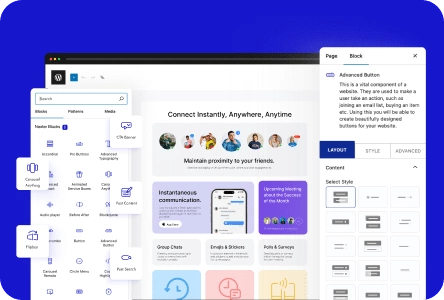Is your WordPress website feeling sluggish? Learn how to remove unused JavaScript in WordPress to improve website performance!
One of the biggest culprits behind slow websites is bloated code, and a major contributor to that bloat is often unused JavaScript. Unused JavaScript takes up space and slows things down.
Sluggish websites take forever to load, frustrating your visitors and potentially driving them away.
When you remove unused JS on WordPress, you can increase loading times, create better user experiences, and potentially rank higher in search engines.
Let’s explore how you can remove unused JavaScript on WordPress.
What Does Unused JavaScript Mean?
Unused JavaScript is code on your website that serves no functional purpose. When a user visits your website, their browser downloads all the code, including JavaScript files. These files dictate the interactive elements and dynamic actions on your site.
However, if some JavaScript is not actively contributing to the website’s functionality, it creates unnecessary overhead.
The browser’s workload directly impacts your website’s loading speed. More code translates to a longer download time, delaying the display of your website.
Unused code in JavaScript can originate from:
- Themes and Plugins: WordPress themes and plugins often include JavaScript for features you may not utilize.
- Third-Party Scripts: Embedded content like social media widgets or analytics trackers can introduce unnecessary JavaScript.
- Outdated Code: As websites evolve, some JavaScript code may become redundant.
Why Should You Remove Unused JavaScript From Your WordPress Website?
While unused JavaScript code can seem insignificant, it can have a huge impact on your WordPress website. Here’s why you should remove it:
- Improved Website Speed and Performance: JavaScript files contribute to the overall size of your web pages. Unused code in JavaScript adds to this workload, increasing page load times. By removing it, you reduce the amount of data the browser needs to handle, leading to faster loading speeds and improved overall website performance.
- Enhanced User Experience: Website speed directly affects user interaction and experience. Slow-loading websites frustrate visitors, leading to higher bounce rates and decreased engagement. Removing unused scripts ensures a smoother, more responsive experience for your audience.
- Reduced Resource Consumption: Every line of JavaScript code requires processing power and bandwidth. Unused JavaScript consumes these resources unnecessarily, potentially leading to higher hosting costs and slower server response times. Removing it optimizes resource utilization.
- Improved Website Maintainability: A clean codebase is easier to manage and update. Removing unused JavaScript simplifies your website’s code, making it easier for developers to identify and fix bugs, implement new features, and perform maintenance tasks.
Want to improve user experience with a more navigable website? Learn how to create sticky header navigation in WordPress.
How to Identify the Largest JavaScript Files on Your Website?
Before you can remove unused JavaScript, you need to know which files are the biggest culprits. Here are two effective tools to help you pinpoint those hefty JavaScript files:
Google PageSpeed Insights
![How to Remove Unused JavaScript in WordPress [10 Easy Ways] 5 Google PageSpeed Insights](https://nexterwp.com/wp-content/uploads/2025/01/Google-PageSpeed-Insights.webp)
Go to the PageSpeed Insights website. Enter your website’s URL and click “Analyze.” Once the analysis is complete, scroll down to the “Opportunities” section. Look for the “Reduce unused JavaScript” suggestion. Expand this section to see a list of JavaScript files that are contributing to slow load times. Pay attention to the files with the largest sizes and consider them for optimization or removal.
GTmetrix
![How to Remove Unused JavaScript in WordPress [10 Easy Ways] 6](https://nexterwp.com/wp-content/uploads/2025/01/GTmetrix.webp)
Go to the GTmetrix website. Enter your website’s URL and click “Test your site.” After the analysis is complete, go to the “Waterfall” tab. Click on the “JS” tab to view a list of all JavaScript files loaded on your page. The files are listed in the order they load, with their file sizes indicated. Identify the largest JavaScript files and investigate their purpose and necessity.
How to Remove Unused JavaScript in WordPress [Working Methods]
Now that you’ve identified the largest JavaScript files, let’s explore some effective methods to remove unused JavaScript and optimize your WordPress website.
1. Delay JavaScript Execution
Delaying the loading of non-critical JavaScript files can improve your website’s initial load time. This technique allows the browser to prioritize loading the visible content of your page first to improve load speeds.
Use a Plugin: Several WordPress plugins, such as Async JavaScript and WP Rocket, offer easy-to-use options to delay JavaScript execution. Install and activate one of these plugins and configure its settings to defer the loading of JavaScript files that are not essential for the initial page display.
Manual Implementation: If you’re comfortable editing your theme’s functions.php file, you can manually add the defer attribute to your script tags. This tells the browser to load the JavaScript file after the HTML parsing is complete.
2. Replace Bloated Plugins
Some WordPress plugins are notorious for adding excessive JavaScript to your website. Identify these plugins and consider replacing them with lighter alternatives that offer similar functionality without the performance overhead.
Use tools like PageSpeed Insights and GTmetrix to identify plugins that are contributing significantly to your website’s JavaScript load. Look for plugins with a reputation for being lightweight and efficient. Read reviews and compare features to find suitable replacements.
After replacing a plugin, test your website thoroughly to ensure all functionalities are working as expected.
Have an image heavy website? Learn more about JPG Vs PNG: Which Format Improves Site Speed?
3. Install an Optimization Plugin
Several WordPress plugins specialize in optimizing website performance, including the removal of unused JavaScript. These plugins often offer a suite of features to improve your website’s speed and efficiency.
Consider plugins like Asset CleanUp, Page Speed Booster, WP Rocket, or Perfmatters. Explore the plugin’s settings to enable features like JavaScript minification, deferral, and unused JavaScript removal.
Monitor your website’s performance after implementing the plugin and adjust settings as needed to achieve optimal results.
4. Minify JavaScript
Minification removes unnecessary characters from your JavaScript files, such as whitespace and comments, without affecting functionality. This reduces file sizes and improves loading times.
Many optimization plugins, like WP Rocket or Autoptimize, include JavaScript minification features as part of their functionality.
If you prefer a more hands-on approach, you can utilize online JavaScript minification tools to compress your files manually. For developers, integrating JavaScript minification into your website’s build process using tools like Webpack or Grunt offers a more streamlined and automated approach.
5. Use Lighter Plugins
When choosing plugins for your WordPress website, prioritize those that are known for being lightweight and efficient. Avoid bloated plugins that are packed with features you don’t need, as they often come with a lot of unnecessary JavaScript.
You can start by paying attention to user reviews that mention plugin performance and speed. Before installing a plugin, check its file size to get an idea of its potential impact on your website’s performance. Opt for plugins that focus on specific functionalities rather than all-in-one solutions that often include bloated code.
6. Defer Scripts or Load Them Asynchronously
Deferring or asynchronously loading non-critical JavaScript files can significantly improve initial page load time. This allows the browser to prioritize rendering the visible content first.
Deferring: The defer attribute instructs the browser to execute the script only after the HTML parsing is complete. This is useful for scripts that are not essential for the initial page display.
Asynchronous Loading: The async attribute allows the script to download simultaneously with HTML parsing and execute as soon as it’s ready. This is suitable for independent scripts that don’t rely on other scripts to function.
You can use plugins like Async JavaScript or manually add the defer or async attributes to your script tags in your theme’s header.php file.
7. Remove Unused Plugins
Unused plugins can clutter your website and contribute to unnecessary JavaScript. Regularly review your plugin list and deactivate or delete any plugins you’re not actively using.
In your WordPress dashboard, navigate to Plugins>Installed Plugins. Deactivate and delete any plugins that are no longer necessary for your website’s functionality.
Want to find the right language to code your website in? Here are the 10 best programming languages for web development.
8. Optimize Third-Party Scripts
Third-party scripts, such as those from Google Analytics or social media widgets, can add JavaScript to your website. Optimize these scripts to minimize their impact on performance.
Whenever possible, host third-party scripts locally on your server to reduce external requests. Load third-party scripts asynchronously to prevent them from blocking page rendering.
Explore alternative solutions that offer similar functionality with less JavaScript overhead.
9. Use a Content Delivery Network (CDN)
A CDN stores a cached version of your website’s files on servers around the world. This allows visitors to access your website from the server closest to their location, reducing latency and improving loading times.
Select a reputable CDN provider like Cloudflare, StackPath, or Amazon CloudFront. Configure your CDN to cache your website’s static assets, including JavaScript files.
10. Manually Remove Unused JavaScript
If you have coding experience, you can manually remove unused JavaScript from your theme’s files or use a code editor to identify and delete unnecessary code snippets. Use browser developer tools or code analysis tools to pinpoint unused JavaScript code.
Note: Exercise caution when manually removing code, as deleting essential JavaScript can break your website’s functionality. Always back up your files before making any changes.
Stay updated with Helpful WordPress Tips, Insider Insights, and Exclusive Updates – Subscribe now to keep up with Everything Happening on WordPress!
Wrapping Up
Every byte of data counts when it comes to website speed. By eliminating unnecessary JavaScript, you’re not only improving loading times but also enhancing user experience, boosting SEO, and contributing to a more efficient and sustainable web.
Looking for a lightweight and efficient way to enhance your WordPress website without adding unnecessary bloat? Consider Nexter Blocks, a powerful yet lightweight plugin that provides 90+ Gutenberg blocks to supercharge your content creation.
With a focus on performance and user experience, Nexter Blocks empowers you to build stunning websites without compromising on speed or efficiency.
FAQs on Removing Unused JavaScript from WordPress
Is it okay to delete JavaScript files?
It depends. Deleting essential JavaScript files can break website functionality which would lead to features malfunctioning or a complete site breakdown. However, removing unused or redundant JavaScript files can improve website performance by reducing page load times. Ensure to identify and remove only the unnecessary files so that core functionalities remain intact.
Can I defer or async all JavaScript files?
While deferring or async-ing JavaScript files can improve initial page load time, it’s not always recommended for all files. “defer” executes the script after HTML parsing is complete, while “async” allows the script to download simultaneously with HTML parsing and executes it immediately. Some scripts might not work correctly if deferred or async-ed.
Is it safe to remove JavaScript from WordPress themes and plugins?
Removing JavaScript from WordPress themes and plugins can be risky, as it might break functionalities provided by those themes or plugins. Themes and plugins often rely on JavaScript for features like sliders, contact forms, and interactive elements. Before removing any JavaScript, it’s essential to understand its purpose and potential impact.
What are the best practices to avoid unused JS?
To avoid unused JavaScript, start by identifying and removing unnecessary third-party scripts, such as those from social media widgets or analytics platforms. Use code splitting techniques to load JavaScript only when needed, ensuring that specific functionalities are delivered only to users who require them. Regularly audit and analyze your website’s JavaScript usage.
Is it better to remove unused CSS or JavaScript first?
While both unused CSS and JavaScript contribute to website bloat, prioritizing unused JavaScript removal often yields more significant performance improvements. JavaScript is generally more resource-intensive than CSS, affecting page load time and user experience more significantly. Removing unused JavaScript can lead to faster rendering, improved interactivity, and reduced time to first paint.
What should I do if removing unused JavaScript breaks my WordPress site?
If removing unused JavaScript breaks your WordPress site, the first step is to restore the original files or revert to a previous backup. Then, carefully analyze the removed JavaScript code to understand its purpose and identify any dependencies. Consider using browser developer tools to debug and pinpoint the specific functionality affected by the removal.











